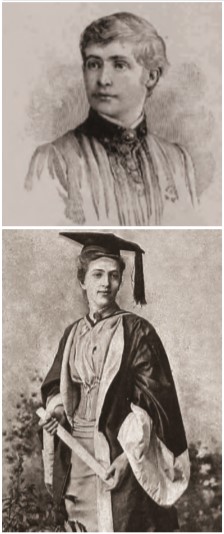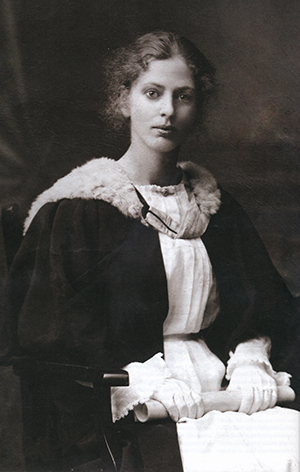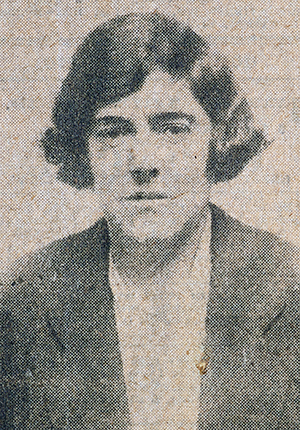LEGAL: Ladies of the law
Published in Issue 1 (January/February 2021), Volume 29The pioneering women in Irish legal history.
By John Lucey

Letitia Walkington (above) and Frances Gray (below)—the first two women conferred Doctor of Laws in Ireland in 1890. (Illustrated London News, 13 November 1897, and The Sketch, 29 August 1894)
In the 1880s women could study law in Ireland but were unable to practise. By the following decade the first women doctors were practising, but those wishing to work as barristers and solicitors would have to wait a further three decades to do so.
Two Belfast-born women, Letitia Alice Walkington (1857–1918) and Frances Helena Gray (1865–1947), were conferred Doctor of Laws by the Royal University of Ireland in 1890, the only two women then entitled to attach the letters LLD to their names. They have the distinction of being the first women to take a degree in laws in any British or Irish university. On completion of her doctorate Walkington was offered chamber work in some solicitors’ offices, which she declined. Although she could not do so, Walkington maintained that she never intended to practise law and instead actively promoted women’s welfare and higher education. With her hair cropped short in manly style, she cut a distinctly boyish figure and never married. She was a pioneer of women’s suffrage but, somewhat poignantly, died in May 1918, just a few months after the franchise was granted to women.
Frances Gray also knew that she could not practise and became a schoolmistress in England. She left that post when she became engaged to a doctor, Stephen Moxley, who had studied medicine at Queen’s College Cork, but he died on the day before they were to be married in July 1893. In 1895 she married Longford-born John Henry Patterson, an army officer, big-game hunter and Zionism advocate. She lived an eventful life with him and died six weeks after him in California in 1947, coincidently in the same year that a Jewish state, which her husband had championed and which would become Israel the following year, was created.
In 1912 Walkington had, vexatiously, written to the King’s Inns asking whether, on paying the ordinary entrance fees, she could be admitted as a law student. No such permission was forthcoming from the benchers!
Legal landmark
Following the granting of the vote to adult women in 1918, a bill to amend the law with respect to discrimination on the grounds of sex was introduced. It was largely seen as a concession to public opinion on the contribution of women during the First World War. The passing of the Sex Disqualification (Removal) Act, on 23 December 1919, opened the doors into the legal professions for women. Following its enactment, women could become students of the Inns of Court with a view to being called to the bar and could take examinations to qualify as solicitors. A month after the passing of the act, the first women were admitted as students to the King’s Inns and the Incorporated Law Society.
Barrier-breaking barristers
The first two Irish women students were admitted to the King’s Inns in January 1920. Ireland had the first two female barristers in the United Kingdom; Frances Christina Kyle (1893–1958) of Belfast and Averil Katherine Slatter Deverell (1893–1979) of Dublin, both graduates of Trinity College, were called to the Irish bar in November 1921. Because they both had LLB degrees they did not have to complete the full number of terms at the King’s Inns before their ‘calls’.
Frances Kyle gained the highest mark in the final bar examination of 1921, thereby winning the John Brooke Scholarship, the blue riband of the King’s Inns. A week after being called to the bar in Dublin, on 1 November 1921, she was called to the bar in Northern Ireland. Not only was she the first female barrister but she also became the first woman member of a circuit in the UK when elected a member of the circuit of Northern Ireland in June 1922. She was the first to hold a brief in an Irish court and in her first year of practice was reported to already have had eight cases. However, she only ever after practised her profession periodically before returning to private life in Belfast. She afterwards moved to London and died at Hampstead in June 1958.
Averil Deverell served as a nursing sister with the British Red Cross and the French Red Cross during the First World War after graduating BA and LLB from Trinity College, Dublin, and resumed her law studies afterwards. She was called to the bar with her twin brother, William, in 1921 and began practising as a barrister in January 1922, becoming the first woman to practise in Britain or Ireland. She was a member of both the Northern and Southern bars and in 1928 was the junior counsel in the appeal regarding the position of civil servants transferred from the United Kingdom to the Irish Free State, becoming the first female Irish barrister to appear before the privy council in London. She had already been the first woman to appear in the Supreme Court of Ireland and in the Court of Criminal Appeal (Ireland). Deverell continued to practise as a barrister until her retirement in 1969 and was known in the Law Library as the ‘mother of the bar’.
Kyle and Deverell had petitioned the Lord Chief Justice for a special dispensation from wearing the wig in court but to no avail. The early women barristers did not readily receive briefs and it was said at the time that ‘the courtroom public were woman-wary to the point of superstition’. The number of Irishwomen called to the bar in Dublin, Belfast and London between 1921 and 1930 was just sixteen.
Singular solicitors

Above: Dorothea Heron—the first woman admitted as solicitor by the Incorporated Law Society of Ireland. (Belfast Telegraph, 5 February 1923)
A year after the first women barristers began to practise, the first two women were admitted as solicitors by the Incorporated Law Society of Ireland. Mary Dorothea Heron (1896–1960) was admitted to the roll of solicitors on 17 April 1923, followed by Helena Mary Early (1888–1977) on 25 June 1923.
Helena Early, from Swords, was a law clerk in her brother’s office (T. Early of Henry Street, Dublin) and in February 1920 had attended the court of examiners to answer questions ‘put to her touching her clerkship’, which recommended that her application ‘for leave to be bound’ be granted. She was the first woman to obtain liberty, under Section 16 of the Solicitors (Ireland) Act, to become bound for the short term of three years. Early has the distinctions of being the first female auditor of the Solicitors’ Apprentices Debating Society of Ireland (1921–2), the first female solicitor in Saorstát Éireann and the first woman to practise anywhere in Ireland. After a long and successful career as a lawyer she retired in 1971 and died on 1 August 1977.Dorothea Heron served her apprenticeship in the office of her uncle (T.M. Heron of Mayfair, Belfast), to whom she had become indentured in February 1920. She was not interested in court work, being content with the routine of a chamber practice in conveyancing, probate, bankruptcy and in advising clients. She practised in Belfast until 1946, when she retired to Portstewart; she died in hospital on 9 October 1960, aged 64, from a cerebral haemorrhage.
Between 1923 and 1930, just twenty women were admitted as solicitors in Dublin and Belfast, with the majority not taking out annual practising certificates for one reason—usually marriage—or another.
Legal legacy

Above: Helena Early—the first female solicitor in Saorstat Éireann and the first woman to practise anywhere in Ireland. (Freeman’s Journal, 30 June 1923)
The pioneering women of the legal professions had to contend not only with gender barriers but also with the fact that when their time came, in 1921–3, it was in a difficult period of Irish history. The first woman solicitor in the then Saorstat was admitted in the week of June 1923 that marked the first anniversary of the battle of the Four Courts, when it was partially destroyed.
In the earlier years of their legal careers many women largely confined themselves to work in chambers, but some did appear in court. In 1922 Frances Kyle had feared that the first women barristers would not succeed in making a living at the bar. While legal friends had advised her to devote her time to conveyancing, which does not require attendance at the courts, Kyle felt ‘that the first woman barrister should practise, if possible, to prepare the way for those who follow’. She, Deverell, Heron and Early were pioneers who did pave the way for the women who followed their footsteps into the legal professions. In addition, Deverell has left a lasting legacy in the form of a bequest to her Alma Mater, setting up a lectureship at the Law School in Trinity College, Dublin, which now bears her name.
The Sex Disqualification (Removal) Act of 1919 was a notable landmark in the annals of legal history, coming a year after women had gained the right to vote. Charles Gamble (1867–1934), then president of the Incorporated Law Society of Ireland, wrote that ‘its developments will be viewed with considerable interest and curiosity’. Viewing its developments a century later, it can be said that, while it was slow in the beginning, the rate of progression for women has accelerated in recent years to the extent that, in the case of practising solicitors, the gender gap in the profession is now in their favour.In the earlier years of their legal careers many women largely confined themselves to work in chambers, but some did appear in court. In 1922 Frances Kyle had feared that the first women barristers would not succeed in making a living at the bar. While legal friends had advised her to devote her time to conveyancing, which does not require attendance at the courts, Kyle felt ‘that the first woman barrister should practise, if possible, to prepare the way for those who follow’. She, Deverell, Heron and Early were pioneers who did pave the way for the women who followed their footsteps into the legal professions. In addition, Deverell has left a lasting legacy in the form of a bequest to her Alma Mater, setting up a lectureship at the Law School in Trinity College, Dublin, which now bears her name.
Only one, however, of the barrier-breaking barristers was ever called to the inner bar. The first woman to take silk was Frances Elizabeth Moran (1892–1977), who was admitted on 9 May 1941 but who never practised at the bar, being instead an outstanding academic at Trinity and becoming the first female professor of law in Ireland. Not until 1977 did the first female senior counsel (SC) practise at the bar of Ireland, and it took another twelve years for the first woman to become a queen’s counsel (QC) in Northern Ireland. In the Republic, although women now make up some 40% of the Law Library’s membership, there still remains a gender gap, with less than half of that proportion senior counsels.
John Lucey is a biographical historian living in Kilkenny.
Read More:
Irishwomen called to the bar, 1921–30
A century of first female milestones in Irish legal history
FURTHER READING
I. Bacik, C. Costello & E. Drew, Gender InJustice: feminising the legal professions? (Dublin, 2003).
E.G. Hall & D. Hogan (eds), The Law Society of Ireland, 1852–2002: portrait of a profession (Dublin, 2002).
T. Kelly, ‘Profession’s perfect parity’, Law Society Gazette (Jan./Feb. 2015).
E. Rackley & R. Auchmuty (eds), Women’s legal landmarks (Oxford, 2019).
















